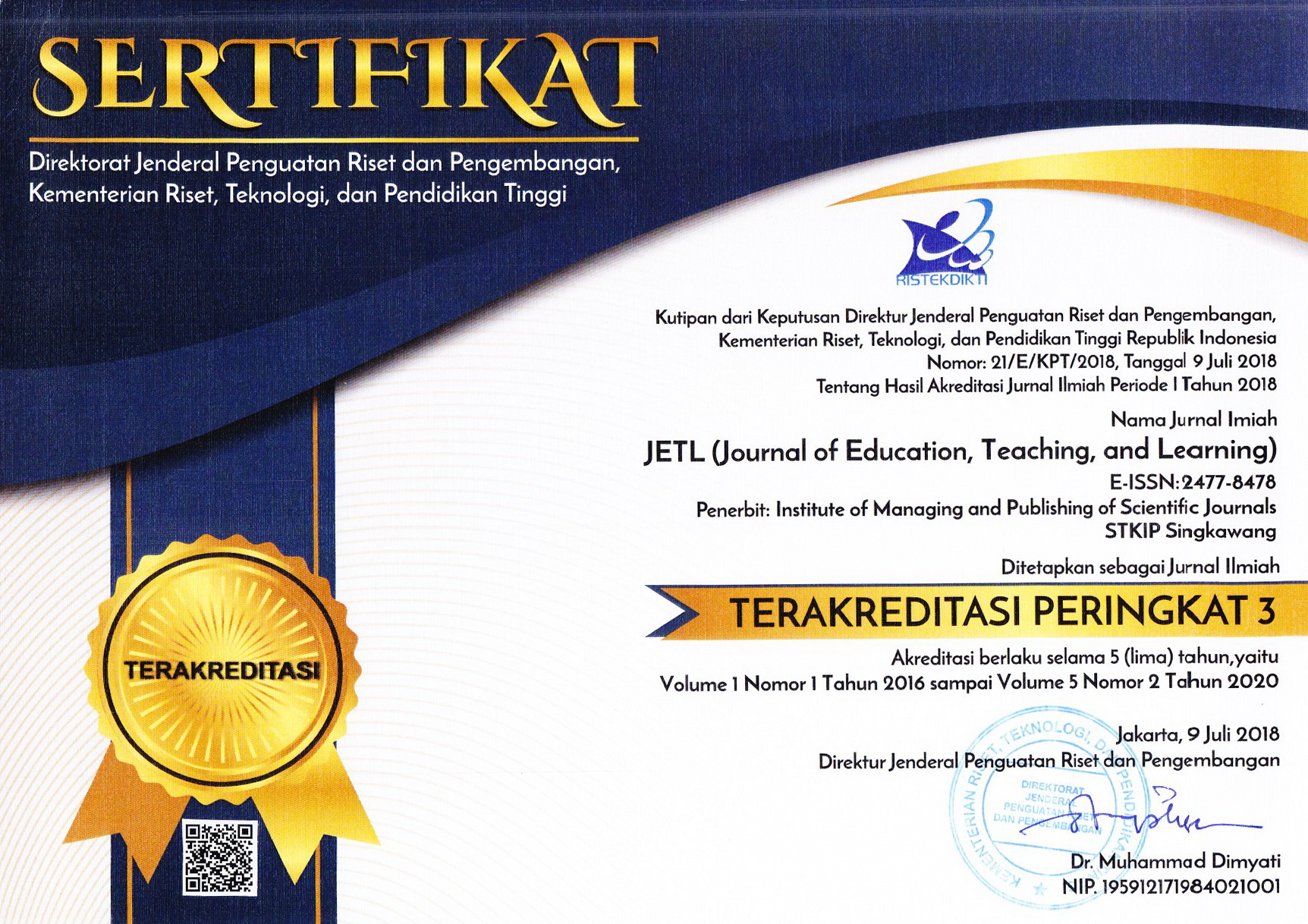The Effect of Screen Size on Students’ Cognitive Load in Mobile Learning
Abstract
Mobile learning is becoming a crucial tool in this era of face-to-face shutdown of education, and however the whole process currently faces a significant deficiency due to the kind of cognitive load that does exist and its relation with mobile device screen display size. It is well-established that certain screen sizes are more effective than others. This study aims to investigate the effect of screen size on students’ cognitive load in mobile learning. Specifically, it investigates whether screen size has a role in cognitive role and draws a comparison to reflect on the most effective size to be used in the context of mobile learning. Other factors that might interfere in the process were also investigated which include course content, gender, age, and students' GPA to see whether they play any additional role in burdening the cognitive load when using different screen sizes. To test the effect of screen size on cognitive load, an online survey was distributed to 1,570 students of the University of Jeddah who are studying at the foundation year for the academic year of 2018-2018, particularly for eight online courses. The sample was chosen randomly, where all members of the population, 6,500 students, had equal opportunities to participate in the study. Participants were invited via e-mail by sending an invitation to participate along with the questionnaire link on the "Qualrrics" platform. This research data analysis technique used ANOVA and curve estimation. The research findings revealed that small screen display size produces the lowest cognitive load as compared with larger display screens. This study also supports the use mobile learning process and gives recommendations to the instructional designers in order to make learning experiences more effective. The results of this study suggest a proper use of screen size can improve learning from smartphones, making them equal to learning from laptops and reducing the overloaded cognitive load that may affect students' understanding and hinder retention. Hence, implications were discussed, and further research recommendations were then provided.
Keywords
Full Text:
PDFReferences
Alalwan, A. A., Baabdullah, A. M., Rana, N. P., Tamilmani, K., & Dwivedi, Y. K. (2018). Examining adoption of mobile internet in Saudi Arabia: Extending TAM with perceived enjoyment, innovativeness and trust. Technology in Society, 55, 100-110. doi:https://doi.org/10.1016/j.techsoc.2018.06.007
Anderson, E. K. (2013). Mobile Learning. In R. Richey (Ed.), Encyclopedia of terminology for educational communications and technology (pp. 214-215). NY: Springer.
Badawi, Z. (2014). miqyas aleib' almaerifii [Cognitive Load Scale]. Cairo: Dar Al-Ketab Alhadeeth.
Brunken, R., Plass, J. L., & Leutner, D. (2003). Direct measurement of cognitive load in multimedia learning. Educational Psychologist, 38(1), 53-61.
Brünken, R., Plass, J. L., & Leutner, D. (2004). Assessment of Cognitive Load in Multimedia Learning with Dual-Task Methodology: Auditory Load and Modality Effects. Instructional Science, 32(1), 115-132. doi:10.1023/B:TRUC.0000021812.96911.c5
Byrd, K. S., & Caldwell, B. S. (2011). Increased memory load during task completion when procedures are presented on mobile screens. Behaviour & Information Technology, 30(5), 643-658. doi:10.1080/0144929X.2010.529944
Castro, S. (2017). How Handheld Mobile Device Size and Hand Location May Affect Divided Attention.
Chae, M., & Kim, J. (2004). Do size and structure matter to mobile users? An empirical study of the effects of screen size, information structure, and task complexity on user activities with standard web phones. Behaviour & Information Technology, 23(3), 165-181. doi:10.1080/01449290410001669923
Chang, C. C., Lei, H., & Tseng, J. S. (2011). Media presentation mode, English listening comprehension and cognitive load in ubiquitous learning environments: Modality effect or redundancy effect? Australasian journal of educational technology, 27(4), 633-654.
Chee, K. N., Yahaya, N., Ibrahim, N. H., & Hasan, M. N. (2017). Review of Mobile Learning Trends 2010-2015: A Meta-Analysis. Journal of Educational Technology & Society, 20(2), 113-126.
Chen, J. (2010, 30-31 May). Reducing cognitive load in mobile learning: Activity-centered perspectives. Paper presented at the Networking and Digital Society (ICNDS), 2010 2nd International Conference on.
Cheng, P.-Y., Huang, Y.-M., Shadiev, R., Hsu, C.-W., & Chu, S.-T. (2014). Investigating the Effectiveness of Video Segmentation on Decreasing Learners’ Cognitive Load in Mobile Learning. In Y. Cao, T. Väljataga, J. K. T. Tang, H. Leung, & M. Laanpere (Eds.), New Horizons in Web Based Learning (Vol. 8699, pp. 122-129): Springer International Publishing.
Cross, L. H., & Belli, G. M. (2004). Experimental research to inform educational policy. In K. deMarrais & S. D. Lapan (Eds.), Foundations for Research: Methods of Inquiry in Education and the Social Sciences (pp. 329). Mahwah, NJ: Lawrence Erlbaum Associates.
Deegan, R. (2015). Complex Mobile Learning that Adapts to Learners' Cognitive Load. International Journal of Mobile and Blended Learning (IJMBL), 7(1), 13-24. doi:10.4018/ijmbl.2015010102
Furió, D., González-Gancedo, S., Juan, M. C., Seguí, I., & Costa, M. (2013). The effects of the size and weight of a mobile device on an educational game. Computers & Education, 64, 24–41. doi:10.1016/j.compedu.2012.12.015
Ghamdi, E., Yunus, F., Da'ar, O., El-Metwally, A., Khalifa, M., Aldossari, B., & Househ, M. (2015). The Effect of Screen Size on Mobile Phone User Comprehension of Health Information and Application Structure: An Experimental Approach. Journal of medical systems, 40, 11. doi:10.1007/s10916-015-0381-5
Hou, J., Nam, Y., Peng, W., & Lee, K. (2012). Effects of screen size, viewing angle, and players' immersion tendencies on game experience. Computers in Human Behavior, 28, 617-623. doi:10.1016/j.chb.2011.11.007
Hu, C.-Y., Lin, H.-Y., & Chen, L.-C. (2016). The effects of screen size on rotating 3D contents using compound gestures on a mobile device. Displays, 41, 25-32. doi:https://doi.org/10.1016/j.displa.2015.11.002
Hwang, G.-J., Wu, P.-H., Zhuang, Y.-Y., Kuo, W.-L., & Huang, Y.-M. (2010, 12-16 April). An Investigation on Students' Cognitive Load and Learning Achievements for Participating in a Local Culture Mobile Learning Activity. Paper presented at the Wireless, Mobile and Ubiquitous Technologies in Education (WMUTE), 2010 6th IEEE International Conference on.
Karam, A. (2015). A comparison of the effects of mobile device display size and orientation, and text segmentation on learning, cognitive load, and user perception in a higher education chemistry course.
Kim, D., & Kim, D.-J. (2012). Effect of screen size on multimedia vocabulary learning. British Journal of Educational Technology, 43, 62-70. doi:10.1111/j.1467-8535.2010.01145.x
Kim, K. J., & Sundar, S. S. (2014). Does screen size matter for smartphones? Utilitarian and hedonic effects of screen size on smartphone adoption. Cyberpsychology, behavior and social networking, 17. doi:10.1089/cyber.2013.0492
Kim, K. J., & Sundar, S. S. (2016). Mobile persuasion: Can screen size and presentation mode make a difference to trust? Human Communication Research, 42, 45-70. doi:10.1111/hcre.12064
Klepsch, M., Schmitz, F., & Seufert, T. (2017). Development and Validation of Two Instruments Measuring Intrinsic, Extraneous, and Germane Cognitive Load. Frontiers in Psychology, 8. doi:10.3389/fpsyg.2017.01997
Liu, T.-C., Lin, Y.-C., & Paas, F. (2013). Effects of Cues and Real Objects on Learning in a Mobile Device Supported Environment. British Journal of Educational Technology, 44(3), 386.
Nipan, M., Emily, B., Hand, S., & George, A. (2008). The Effect of Mobile Phone Screen Size on Video Based Learning. Journal of Software, 3. doi:10.4304/jsw.3.4.51-61
Paas, F., Tuovinen, J., Tabbers, H., & Van Gerven, P. (2003). Cognitive Load Measurement as a Means to Advance Cognitive Load Theory. Educational Psychologist - Educ Psychol, 38, 63-71. doi:10.1207/S15326985EP3801_8
Paas, F., Van Merrienboer, J. J. G., & Adam, J. (1994). Measurement of cognitive load in instructional research. Perceptual and motor skills, 79, 419-430. doi:10.2466/pms.1994.79.1.419
Papanikolaou, K., & Mavromoustakos, S. (2006). Critical Success Factors for the Development of Mobile Learning Applications.
Park, Babette & Moreno, Roxana & Seufert, Tina & Brünken, Roland. (2011). Does cognitive load moderate the seductive details effect? A multimedia study. Computers in Human Behavior. 27. 5-10. 10.1016/j.chb.2010.05.006.
Park, E., Han, J., Kim, K. J., Cho, Y., & del Pobil, A. P. (2018). Effects of screen size in mobile learning over time.
Parsazadeh, N., Ali, R., & Rezaei, M. (2018). A framework for cooperative and interactive mobile learning to improve online information evaluation skills. Computers & Education, 120, 75-89. doi:https://doi.org/10.1016/j.compedu.2018.01.010
Raptis, D., Tselios, N., Kjeldskov, J., & Skov, M. (2013). Does size matter? Investigating the impact of mobile phone screen size on users’ perceived usability, effectiveness and efficiency.
Sanchez, C. A., & Naylor, J. S. (2018). Disfluent presentations lead to the creation of more false memories. PLOS ONE, 13(1), e0191735. doi:10.1371/journal.pone.0191735
Shadiev, R., Hwang, W.-Y., Huang, Y.-M., & Liu, T.-Y. (2015). The impact of supported and annotated mobile learning on achievement and cognitive load. Journal of Educational Technology & Society, 18(4), 53-69.
Sluis, F., van den Broek, E. L., Drunen, A., & Beerends, J. (2018). Mobile Screen Size Limits Multimodal Synergy.
So, S. (2016). Mobile instant messaging support for teaching and learning in higher education. The Internet and Higher Education, 31, 32-42. doi:https://doi.org/10.1016/j.iheduc.2016.06.001
Sweller, J. (1988). Cognitive Load During Problem Solving: Effects on Learning. Cognitive Science, 12(2), 257-285. doi:10.1207/s15516709cog1202_4
Sweller, J. (1994). Cognitive load theory, learning difficulty, and instructional design. Learning and Instruction, 4(4), 295-312. https://doi.org/10.1146/annurev.anthro.33.070203.144008
Terras, Melody & Ramsay, Judith. (2012). Terras, M.M & Ramsay, J. (2012). Educational Applications of Web 2: A Psychological Perspective. Cyberpsychology and Computer Psychology Conference 2012 - CyComP 2012, Bolton, UK, July 16-17.
Triyason, T., & Krathu, W. (2017). The impact of screen size toward QoE of cloud-based virtual desktop. Procedia Computer Science, 111, 203-208. doi:10.1016/j.procs.2017.06.054
Van Gerven, P. W. M., Paas, F., Van Merriënboer, J. J. G., & Schmidt, H. G. (2004). Memory load and the cognitive pupillary response in aging. Psychophysiology, 41(2), 167-174. doi:10.1111/j.1469-8986.2003.00148.x
Wang, S., & Higgins, M. (2005). Limitations of mobile phone learning (Vol. 2).
Wang, Y., Zhao, Z., Wang, D., Feng, G., & Luo, B. (2013). How screen size influences Chinese readability.
Wenhao David, H., & Jeanette, A. (2014). Design and Evaluation of Mobile Learning from the Perspective of Cognitive Load Management Handbook of Research on Education and Technology in a Changing Society (pp. 291-306). Hershey, PA, USA: IGI Global.
DOI: http://dx.doi.org/10.26737/jetl.v5i2.2203
Refbacks
- There are currently no refbacks.

This work is licensed under a Creative Commons Attribution-NonCommercial 4.0 International License.
Published by:
Institute of Managing and Publishing of Scientific Journals STKIP Singkawang
Sekolah Tinggi Keguruan dan Ilmu Pendidikan (STKIP) Singkawang
Address : STKIP Singkawang, Jalan STKIP - Kelurahan Naram Singkawang, Kalimantan Barat, INDONESIA, 79251
No. Telp. : +62562 420 0344
No. Fax. : +62562 420 0584
JETL (Journal of Education, Teaching, and Learning)
e-ISSN : 2477-8478
p-ISSN : 2477-5924

Editor in Chief Contact: [email protected] / Wa: +6282142072788
Publisher Contact: [email protected] / Wa: +6282142072788
Management Tools
JETL Indexed by:
JETL (Journal of Education, Teaching, and Learning) is licensed under a Creative Commons Attribution-NonCommercial 4.0 International License.











